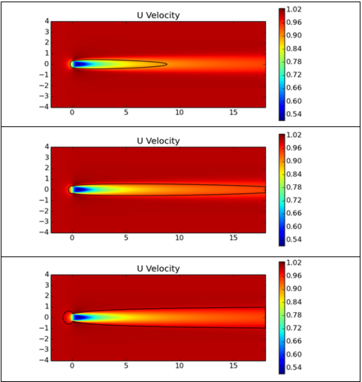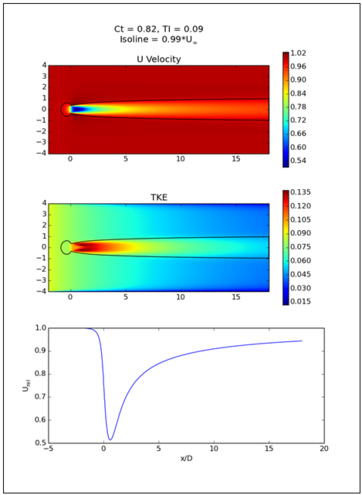Wind Energy
SWiFT facility preparing for more efficient operations and advanced
turbine-turbine wake interaction control research
This
summer, activities at the DOE/SNL SWiFT facility will pick up in preparation
for an enhanced and more efficient site enabling advanced research to be
executed with more rigor. As part of the update, we welcome Dave Mitchell, the SWiFT
site manager, as a permanently stationed Sandia staff member in Lubbock, Texas.
Dave is responsible for day to day operations of the facility.
A comprehensive
design review has been completed, which will progress the facility towards
operations by August 2015. An improved
safety program for the facility was reviewed by staff from SNL, NREL, DNV-GL,
Westergaard Solutions and Vestas. The safety program includes improvements to
the hardware safety systems, control system development process and operating
procedures to support the future needs of the DOE WWPTO A2E program and
partnership projects with academia, industrial partners and national
laboratories. Improvements were made to the hardwired safety system including independent
and redundant sensors. Further, a third independent stopping mechanism (related
to the upgrade of the machines) is being installed in order to expand operating
envelope with variable speed conversion.
Sandia
is also ready to launch a hardware in the loop (HIL) system, which will allow
for full simulation of new controllers based on FAST simulations in a simulated
hardware environment. This will support fast, safe release of new controls
algorithms as they are conceptualized and prepared for release at the full
SWiFT site.
A
newly refurbished Vestas V27 turbine will replace the turbine damaged last year. During May 11-15, Aeronautica Windpower with
onsite SNL support from Bruce LeBlanc, will disassemble the turbine in
Minnesota and begin the refurbishment process.
The new turbine is expected to be erected at SWiFT in January 2016 and
fully operational in June 2016.

Figure 1. Vestas V27 turbine will be erected at SWiFT in
January 2016.
Concurrently
with these efforts, the SWiFT Facility site staff have been advancing the
operational status of the DOE/SNL meteorological tower. All instrumentation has
been installed and data is being collected while some minor issues are being resolved. The tower is expected to be fully operational
by June 2015. Efforts will then transition
to the nearby Vestas meteorological tower which will be operational within two
months.
The
planned summer research includes metrological observations, programming of a
new acoustic measurement system, feasibility testing of several components of
Sandia’s wake imaging system and preparation for testing of several LIDAR
systems in collaboration with Texas Tech and two LIDAR suppliers.
Jonathan White, (505) 284-5400.
 Figure 2. Miguel
Hernandez (Texas Tech staff) servicing anemometer boom.
IEA Task 33
"Reliability Data – Standardization of
Data Collection
for Wind Turbine Reliability and Maintenance Analyses"
The fifth meeting of the IEA Task
33 "Reliability Data – Standardization of Data Collection for Wind Turbine
Reliability and Maintenance Analyses" was held at the Sustainable Energy
Authority of Ireland offices in Dublin, Ireland on April 14, 2015. It was
organized and led by the Task Operating Agent, Berthold Hahn of Fraunhofer
IWES.
The objective of IEA Task 33 is
to address the different developments of data collection and failure statistics
to agree on standards and overall structures. A portion of the IEA Task
33 members were given a technical tour of the EirGrid on the morning of the
first day. Following the tour, the group met and after introductions, a
tabulation of presentations was determined and the following list of
participant presentations was made. The second and third days were structured
with open discussions on key sections of the draft report, which was the major
portion of the meeting. Ben Karlson of Sandia spoke about the Continuous
Reliability Enhancement for Wind (CREW) project and created and distributed
slides after the meeting.

After finishing the work on the
state-of-the-art report, the IEA Wind Task33 team was split up into three
working groups for intensively working on three subtasks:
- Data Collection
- Statistical Analyses
- O&M Tools
The groups completed reports
presenting theoretical knowledge about maintenance strategies, opportunities of
statistical methods, and data capturing and transfer. Thus, a sound basis for
further work has been provided. Much of the meeting discussion focused on
the recent draft of the Recommended Practices document. The document, which is
currently over 100 pages in length, is a compilation of three group reports
that followed from the 2014 meeting.
As part of the discussion on the
draft Recommended Practices document, the need to extend the IEA Task 33 effort
for an additional year was brought up. The feeling was that while working
on the creating the document and completing the recommendations it has revealed
that discussing and finding common suggestions requires more effort than
originally expected and planned. The group agreed that an extension is
needed and the participating organizations agreed to seek commitments from
their respective countries' funding customers. Fraunhofer IWES will
present the Task Extension Proposal at the upcoming IEA ExCo meeting in May
2015.
Finally, there was much
discussion regarding the need for an industry workshop that would likely be
held in September. The objective of the workshop would be to solicit
feedback from the industry on the latest version of the Recommended Practices
document and to ensure the recommendations align with industry
requirements. Dates are being proposed that could take advantage of other
workshops in the September timeframe.
Ben Karlson, (505) 377-3774
Water Power: Wave Energy
SNL-SWAN Webinar to Federal Ocean Renewable Energy Working Group (FROEWG)
On April 16, 2015 the U.S. Department of
Energy hosted a Webinar for the Federal Ocean Renewable Energy Working Group
(FROEWG). FROEWG is a group of federal agencies that meet quarterly to discuss
the status of ocean renewable energy and open lines of communication between
the different federal agencies. Attendees to this FROEWG meeting included
representatives from the following agencies: U.S. Department of Energy (DOE),
Sandia National Laboratories, National Oceanic and Atmospheric Administration, Federal
Energy Regulatory Commission, U.S. Environmental Protection Agency, U.S. Army
Corps of Engineers, National Park Service, Bureau of Safety and Environmental
Enforcement, and Bureau of Ocean Energy Management. Kelley Ruehl from Sandia
National Laboratories presented to FROEWG on, “SNL-SWAN: Open source wave
energy farm modeling code.” The presentation was focused on Sandia National
Laboratories’ development and application of SNL-SWAN, an open source spectral
wave code that has been modified to more accurately represent the energy
extraction of wave energy converters. The purpose of the SNL-SWAN Webinar was
to inform the different regulatory agencies that the code is available and can now
be used in the regulatory and permitting process to evaluation potential
environmental impact of wave farms.
SNL-SWAN can be accessed here.
Kelley Ruehl, (505) 284-8724.
Jesse Roberts, (505) 844-5730.
Water Power: Current Energy
DTOcean: Wake model enhancements
DTOcean is an international project comprised
of multiple European partners and Sandia National Laboratories. One aspect of the
project is to develop a fast-running, easy to use Current Energy Capture (CEC)
array spacing tool that considers tidal array performance versus
efficiency. In support of this effort,
Sandia has been assisting in the development of the device wake modeling sub
module that determines the properties of the wake generated by tidal turbines
(i.e. wake growth and dissipation). The
primary components of this model were developed by Sandia in earlier efforts,
and in recent weeks, Sandia has been working to implement additional features
to this model.
To better assist in the prediction of flow within
turbine array environments, Sandia has added the ability to calculate wake
boundaries as a given percentage of the freestream flow. Figure
3 below
shows the wake boundary calculated at 90, 95 and 99 percent of the freestream
velocity for an example wake. The model can be used to calculate the geometry
of a wake for any defined percentage of the incident velocity; however an exact
definition is still a topic of research.

Figure 3: Wake boundaries defined at 90%, 95%
and 99% of the freestream velocity respectively.
In addition to the wake boundary calculation,
Sandia has increased the fidelity of the model by adding turbulent kinetic
energy to the wake model database. This
added information allows for the calculation of the turbulent intensity flow
field, a quantity that will help support other DTOcean modules, such as device
loading for foundation analysis. Figure
4 below
shows the output of the latest iteration of the wake model with the new wake
boundary calculator and the addition of turbulent kinetic energy into the
database.
Chris
Chartrand, (505) 845-8750.
Jesse
Roberts, (505) 844-5730.

Figure 4: New model output including wake
boundary and turbulent kinetic energy.
|